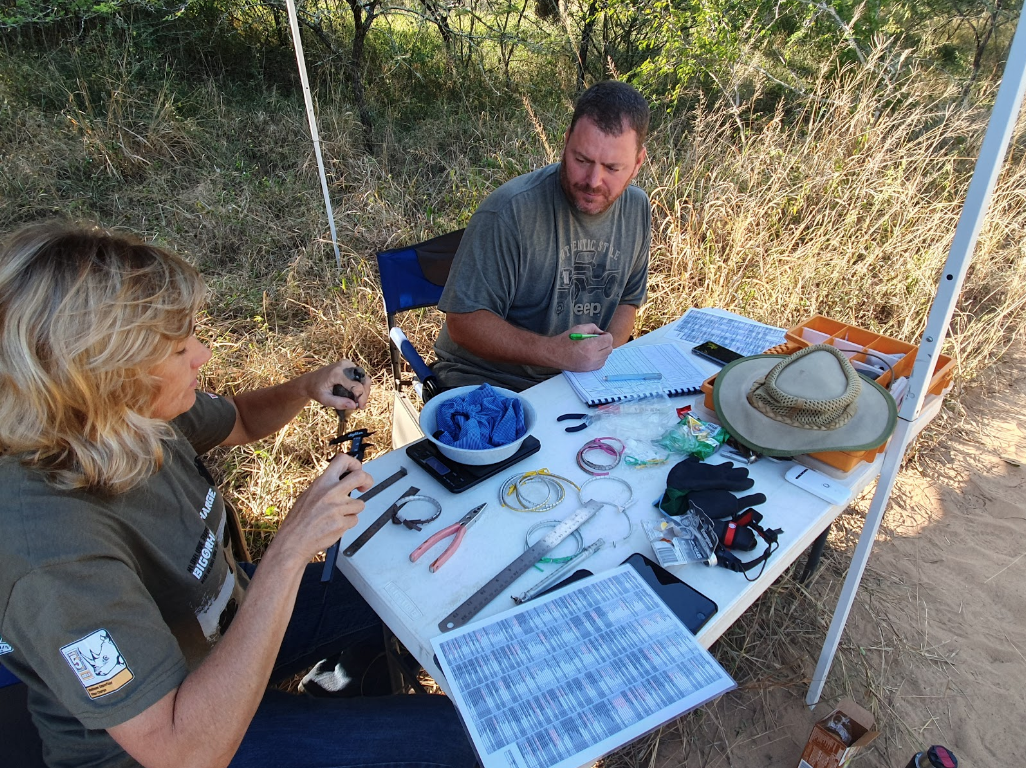OUR FIRST BIRD RINGING SURVEY
The old proverb goes, a bird in the hand is worth two in the bush, and this month across Wild Tomorrow Fund’s conservation properties, that was all too true.
Female Chinspot Batis (Batis molitor)
Pink-throated Twinspot (Hypargos Margaritatus)
Last weekend, Wild Tomorrow Fund completed the first sessions of bird ringing on both the Ukuwela Nature Reserve and the brand new Mfuleni Conservancy. Enrolling the help of local expert bird-ringer James Rawdon, three capture sessions across the two properties yielded an amazing opportunity to see some of the local feathered residents up close as well as collect important scientific information.
Bird ringing, or “banding” as it’s also called, is the process of catching birds and attaching individual metal number tags or rings to their legs for the purpose of identifying them later on. The process involves the setup of mist nets stretching hundreds of meters in a set habitat the evening before and then a pre-sunrise opening of the nets to catch any passing birds as the sun comes up. Birds hitting the soft “mist” nets fall into slacked pouches at the bottom of each section where James then collects them placing them in small cotton sacks. In the capture sacks the birds rest and stay calm until James can process them.
A clutch of 28 birds sit waiting in their capture bags to be processed and ringed. Their time in the bags and the temperature is monitored closely.
A Black-backed Puffback (Dryoscopus cubla) gets a ring fitted.
The rings themselves are specifically made for each species’ size; James has an entire box of more than a couple dozen different ring types that get used for everything from a tiny sunbird to a giant martial eagle. On each ring is a unique number code so future ringing sessions (at the original capture site or somewhere else) can record that specific animal again. Also on each tag is information on how citizen scientists can report finding that bird to the University of Cape Town. The rings are fitted using a clamping tool, ensuring they fit snug enough not to come off, but hang loose enough to not impact the bird’s behavior and movements.
While ringing the birds, James and his apprentice collect information on each bird including age, sex, weight, and measurements of the head, bill, wings, and tail feathers. All of this information is submitted to SAFRING, which is part of the University of Cape Town and adds to numerous projects and ongoing research into the biology and conservation of Southern African birds.
“Through ringing, information on dispersal, migration, longevity, behaviour, survival rate, reproductive success and population trends of migratory birds can be obtained. All this information leads to a better insight of the birds' biology and ecology and their demographic changes over time. This knowledge is an important foundation for successful conservation measures. Whenever ringed birds are found dead, or re-sighted, they can be identified and their movements can be tracked. This helps to identify the critical sites along their migratory routes (flyways) and provides fundamental information for conservation planning and site management.” - James Rawdon
Once the rings are on and the birds are processed, James takes some close-up pictures for a photographic record and then releases the birds back into the wild. In total James and the team caught and ringed 119 birds of 38 species from three morning sessions! (see below)
James and Lara collect body measurements on a Speckled Mousebird (Colius striatus).
Female White-bellied Sunbird (Cinnyris talatala)
Speckled Mousebird (Colius striatus)
During the ringing sessions, Wild Tomorrow Fund’s ecologist Axel and the Ukuwela field rangers, were on site to help with setup and collection of the data. “Bird ringing is an incredible learning opportunity for scientists and everyday people alike. Being able to see these fantastic creatures up close and marvel at the beautiful features and colours is something that is truly extraordinary. Even more important is seeing how our staff responded to being able to hold and release some of the birds; the excitement and awe is infectish. At the end of the day that is perhaps the most important conservation byproduct of this exercise” noted Axel.
One of our Ukuwela rangers, Mzi, held a Brown-crowned Tchagra (Tchagra australis).
That weekend guests from our sister non-profit Biologists Without Borders, who have also helped in making our habitat protection projects possible, were lucky enough to join in on the bird ringing. Most of the group were active or former biologists from the U.S. and many have done this exercise before, but never in Africa. The entire group was captivated by the knowledge of James and the beauty of the birds.
James is a certified bird ringer through the South African Ringing Scheme through the University of Cape Town who collate data collected by bird ringers across the country and ensure a strict code of ethics are followed. This ensures the safe and ethical catching and handling of the birds, while coordinating regional data collection. James has been ringing since 2010 and has ringed 7784 birds of 271 species in South Africa and Sierra Leone. He originally studied biology and worked in the South African and Botswana bush for 10 years managing lodges, guiding, researching lion, and working with local communities. After leaving the bush to start a family and have a corporate life, James missed his involvement in nature and conservation. So he decided to pursue bird ringing as a hobby, a means of contributing to research in urban areas, and a way to involve his children in conservation. “The ringing is important to me as a means of giving something back to conservation and being able to educate others on the importance of our environment and the roles birds play in it. Birds don’t always get as much attention as the larger mammal species so was a good area to focus on.”
Later in the year James will be back on both reserves to do another bird ringing survey in conjunction with Wild Tomorrow Fund’s October volunteer trip. We hope to resurvey some of the sites from this month, but also expand onto the new wildlife corridor close to the iSimangaliso Wetland Park. There James hopes to catch and document the potential presence of the threatened Pink-throated longclaw. October holds high expectations since many migrant species will also be returning to the region. We look forward to our October bird survey!
James holding a female Chinspot Batis (Batis molitor).











